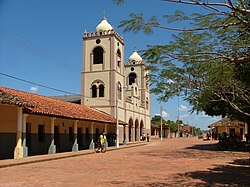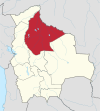You can help expand this article with text translated from
the corresponding article in German. (August 2011) Click [show] for important translation instructions.
|
San Joaquín | |
|---|---|
town | |
 San Joaquín Mission Church | |
| Coordinates: 13°02′29″S 64°40′05″W / 13.04139°S 64.66806°W | |
| Country |
|
| Department |
|
| Province | Mamoré Province |
| Elevation | 466 ft (142 m) |
| Population (est. 2009) | |
| • Total | 4,589 |
| Time zone | UTC-4 (BOT) |
San Joaquín is a small agricultural town in the Beni Department in the Bolivian lowlands.
It is served by San Joaquín Airport.
The Jesuit mission of San Joaquín was founded in 1709. [1] Baure Indians resided at the mission. [2]
Camba Spanish is the primary vernacular lingua franca spoken in the town. The Joaquiniano dialect of Baure is also spoken in San Joaquín. [3] [4]
San Joaquín is the administrative capital of Mamoré Province and is at an elevation of 142 m above sea level. It is just west of the Machupo River, a tributary of the Iténez River.
San Joaquín is 220 kilometres (140 mi) north of Trinidad, the department's capital.
San Joaquín is located in the Moxos Plains (Llanos de Moxos), at 100,000 km2 one of the greatest wetlands of the Earth. Main vegetation in the area of San Joaquín is the tropical savanna.
The yearly precipitation of the region is 1,800 mm, with a distinct dry season from May to September. Monthly average temperatures vary from 24 °C und 29 °C over the year.
| Climate data for San Joaquín, elevation 139 m (456 ft) | |||||||||||||
|---|---|---|---|---|---|---|---|---|---|---|---|---|---|
| Month | Jan | Feb | Mar | Apr | May | Jun | Jul | Aug | Sep | Oct | Nov | Dec | Year |
| Record high °C (°F) | 37.1 (98.8) |
38.0 (100.4) |
38.0 (100.4) |
37.2 (99.0) |
37.4 (99.3) |
37.5 (99.5) |
38.0 (100.4) |
39.5 (103.1) |
40.1 (104.2) |
39.6 (103.3) |
38.5 (101.3) |
37.6 (99.7) |
40.1 (104.2) |
| Mean daily maximum °C (°F) | 31.5 (88.7) |
31.4 (88.5) |
31.5 (88.7) |
31.4 (88.5) |
30.4 (86.7) |
30.3 (86.5) |
31.4 (88.5) |
33.2 (91.8) |
33.6 (92.5) |
33.6 (92.5) |
32.5 (90.5) |
31.8 (89.2) |
31.9 (89.4) |
| Daily mean °C (°F) | 27.1 (80.8) |
27.0 (80.6) |
27.2 (81.0) |
26.8 (80.2) |
25.5 (77.9) |
24.4 (75.9) |
24.2 (75.6) |
25.6 (78.1) |
27.1 (80.8) |
27.8 (82.0) |
27.4 (81.3) |
27.2 (81.0) |
26.4 (79.6) |
| Mean daily minimum °C (°F) | 22.8 (73.0) |
22.6 (72.7) |
22.8 (73.0) |
22.2 (72.0) |
20.4 (68.7) |
18.6 (65.5) |
17.1 (62.8) |
18.0 (64.4) |
20.4 (68.7) |
21.9 (71.4) |
22.3 (72.1) |
22.6 (72.7) |
21.0 (69.8) |
| Record low °C (°F) | 17.9 (64.2) |
13.9 (57.0) |
14.0 (57.2) |
10.5 (50.9) |
9.5 (49.1) |
5.3 (41.5) |
6.8 (44.2) |
5.0 (41.0) |
9.3 (48.7) |
10.8 (51.4) |
14.1 (57.4) |
16.3 (61.3) |
5.0 (41.0) |
| Average precipitation mm (inches) | 282.8 (11.13) |
265.8 (10.46) |
235.4 (9.27) |
132.2 (5.20) |
65.7 (2.59) |
20.7 (0.81) |
18.7 (0.74) |
29.8 (1.17) |
72.2 (2.84) |
135.6 (5.34) |
194.7 (7.67) |
264.3 (10.41) |
1,717.9 (67.63) |
| Average precipitation days | 14.9 | 14.5 | 13.3 | 9.0 | 5.2 | 2.3 | 1.7 | 1.8 | 4.1 | 8.1 | 10.4 | 13.5 | 98.8 |
| Average relative humidity (%) | 80.1 | 80.9 | 80.4 | 78.3 | 76.5 | 73.0 | 64.8 | 62.1 | 63.8 | 69.7 | 75.3 | 78.7 | 73.6 |
| Source: Servicio Nacional de Meteorología e Hidrología de Bolivia [5] [6] | |||||||||||||
Over the past two decades, the town's population has risen by circa 30%, from 3,489 ( census 1992) to 4,094 (census 2001) and 4,589 (2009 estimate). [7] San Joaquin has been the site of a Machupo virus or Bolivian Hemorragic Fever outbreak in the 1960s.
- Jeanine Áñez, politician
- ^ Block, David (1994). Mission culture on the upper Amazon: native tradition, Jesuit enterprise, and secular policy in Moxos, 1660-1880. Lincoln: University of Nebraska Press. ISBN 0-8032-1232-1..
- ^ Meireles, Denise Maldi. 1989. Guardiães da fronteira: Rio Guaporé, século XVIII. Petrópolis: Vozes. ISBN 85-326-0017-4.
- ^ Danielsen, Swintha (2011). The personal paradigms in Baure and other South Arawakan languages. In Antoine Guillaume; Françoise Rose (eds.). International Journal of American Linguistics 77(4): 495-520.
- ^ Danielsen, Swintha; Terhart, Lena (2014). Paunaka. In Mily Crevels; Pieter Muysken (eds.). Lenguas de Bolivia, vol. III: Oriente, pp. 221-258. La Paz: Plural Editores.
- ^ "Base de datos Sistema Meteorológico–SISMET" (in Spanish). Servicio Nacional de Meteorología e Hidrología de Bolivia. Archived from the original on 7 June 2018. Retrieved 15 June 2024.
- ^ "índices climáticos para 149 estaciones meteorológicas en Bolivia" (in Spanish). Servicio Nacional de Meteorología e Hidrología de Bolivia. Retrieved 15 June 2024.
- ^ World Gazetteer[ dead link]
You can help expand this article with text translated from
the corresponding article in German. (August 2011) Click [show] for important translation instructions.
|
San Joaquín | |
|---|---|
town | |
 San Joaquín Mission Church | |
| Coordinates: 13°02′29″S 64°40′05″W / 13.04139°S 64.66806°W | |
| Country |
|
| Department |
|
| Province | Mamoré Province |
| Elevation | 466 ft (142 m) |
| Population (est. 2009) | |
| • Total | 4,589 |
| Time zone | UTC-4 (BOT) |
San Joaquín is a small agricultural town in the Beni Department in the Bolivian lowlands.
It is served by San Joaquín Airport.
The Jesuit mission of San Joaquín was founded in 1709. [1] Baure Indians resided at the mission. [2]
Camba Spanish is the primary vernacular lingua franca spoken in the town. The Joaquiniano dialect of Baure is also spoken in San Joaquín. [3] [4]
San Joaquín is the administrative capital of Mamoré Province and is at an elevation of 142 m above sea level. It is just west of the Machupo River, a tributary of the Iténez River.
San Joaquín is 220 kilometres (140 mi) north of Trinidad, the department's capital.
San Joaquín is located in the Moxos Plains (Llanos de Moxos), at 100,000 km2 one of the greatest wetlands of the Earth. Main vegetation in the area of San Joaquín is the tropical savanna.
The yearly precipitation of the region is 1,800 mm, with a distinct dry season from May to September. Monthly average temperatures vary from 24 °C und 29 °C over the year.
| Climate data for San Joaquín, elevation 139 m (456 ft) | |||||||||||||
|---|---|---|---|---|---|---|---|---|---|---|---|---|---|
| Month | Jan | Feb | Mar | Apr | May | Jun | Jul | Aug | Sep | Oct | Nov | Dec | Year |
| Record high °C (°F) | 37.1 (98.8) |
38.0 (100.4) |
38.0 (100.4) |
37.2 (99.0) |
37.4 (99.3) |
37.5 (99.5) |
38.0 (100.4) |
39.5 (103.1) |
40.1 (104.2) |
39.6 (103.3) |
38.5 (101.3) |
37.6 (99.7) |
40.1 (104.2) |
| Mean daily maximum °C (°F) | 31.5 (88.7) |
31.4 (88.5) |
31.5 (88.7) |
31.4 (88.5) |
30.4 (86.7) |
30.3 (86.5) |
31.4 (88.5) |
33.2 (91.8) |
33.6 (92.5) |
33.6 (92.5) |
32.5 (90.5) |
31.8 (89.2) |
31.9 (89.4) |
| Daily mean °C (°F) | 27.1 (80.8) |
27.0 (80.6) |
27.2 (81.0) |
26.8 (80.2) |
25.5 (77.9) |
24.4 (75.9) |
24.2 (75.6) |
25.6 (78.1) |
27.1 (80.8) |
27.8 (82.0) |
27.4 (81.3) |
27.2 (81.0) |
26.4 (79.6) |
| Mean daily minimum °C (°F) | 22.8 (73.0) |
22.6 (72.7) |
22.8 (73.0) |
22.2 (72.0) |
20.4 (68.7) |
18.6 (65.5) |
17.1 (62.8) |
18.0 (64.4) |
20.4 (68.7) |
21.9 (71.4) |
22.3 (72.1) |
22.6 (72.7) |
21.0 (69.8) |
| Record low °C (°F) | 17.9 (64.2) |
13.9 (57.0) |
14.0 (57.2) |
10.5 (50.9) |
9.5 (49.1) |
5.3 (41.5) |
6.8 (44.2) |
5.0 (41.0) |
9.3 (48.7) |
10.8 (51.4) |
14.1 (57.4) |
16.3 (61.3) |
5.0 (41.0) |
| Average precipitation mm (inches) | 282.8 (11.13) |
265.8 (10.46) |
235.4 (9.27) |
132.2 (5.20) |
65.7 (2.59) |
20.7 (0.81) |
18.7 (0.74) |
29.8 (1.17) |
72.2 (2.84) |
135.6 (5.34) |
194.7 (7.67) |
264.3 (10.41) |
1,717.9 (67.63) |
| Average precipitation days | 14.9 | 14.5 | 13.3 | 9.0 | 5.2 | 2.3 | 1.7 | 1.8 | 4.1 | 8.1 | 10.4 | 13.5 | 98.8 |
| Average relative humidity (%) | 80.1 | 80.9 | 80.4 | 78.3 | 76.5 | 73.0 | 64.8 | 62.1 | 63.8 | 69.7 | 75.3 | 78.7 | 73.6 |
| Source: Servicio Nacional de Meteorología e Hidrología de Bolivia [5] [6] | |||||||||||||
Over the past two decades, the town's population has risen by circa 30%, from 3,489 ( census 1992) to 4,094 (census 2001) and 4,589 (2009 estimate). [7] San Joaquin has been the site of a Machupo virus or Bolivian Hemorragic Fever outbreak in the 1960s.
- Jeanine Áñez, politician
- ^ Block, David (1994). Mission culture on the upper Amazon: native tradition, Jesuit enterprise, and secular policy in Moxos, 1660-1880. Lincoln: University of Nebraska Press. ISBN 0-8032-1232-1..
- ^ Meireles, Denise Maldi. 1989. Guardiães da fronteira: Rio Guaporé, século XVIII. Petrópolis: Vozes. ISBN 85-326-0017-4.
- ^ Danielsen, Swintha (2011). The personal paradigms in Baure and other South Arawakan languages. In Antoine Guillaume; Françoise Rose (eds.). International Journal of American Linguistics 77(4): 495-520.
- ^ Danielsen, Swintha; Terhart, Lena (2014). Paunaka. In Mily Crevels; Pieter Muysken (eds.). Lenguas de Bolivia, vol. III: Oriente, pp. 221-258. La Paz: Plural Editores.
- ^ "Base de datos Sistema Meteorológico–SISMET" (in Spanish). Servicio Nacional de Meteorología e Hidrología de Bolivia. Archived from the original on 7 June 2018. Retrieved 15 June 2024.
- ^ "índices climáticos para 149 estaciones meteorológicas en Bolivia" (in Spanish). Servicio Nacional de Meteorología e Hidrología de Bolivia. Retrieved 15 June 2024.
- ^ World Gazetteer[ dead link]


